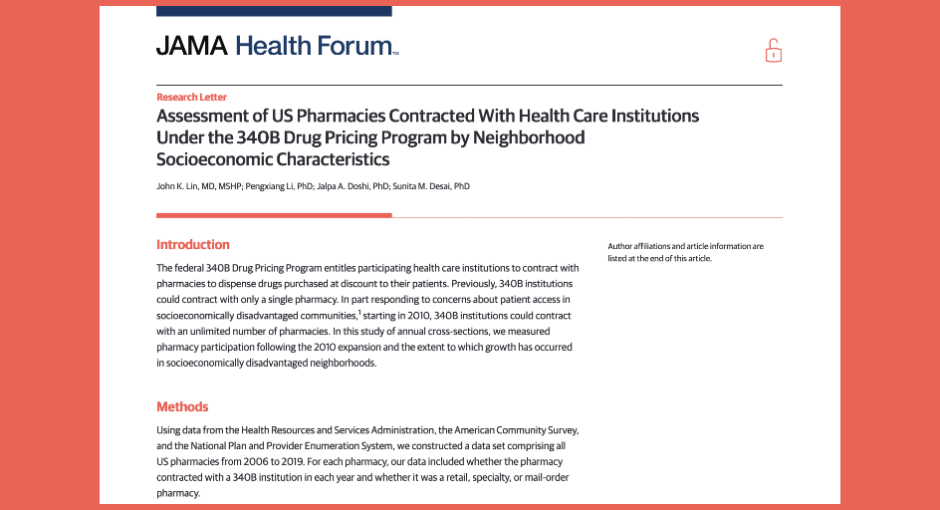340B contract pharmacy grew in affluent and White neighborhoods from 2011 to 2019 but declined in impoverished, Black, and Latino neighborhoods, raising questions about “the degree to which 340B program growth serves vulnerable communities,” according to research published this morning in JAMA Health Forum.
The nation’s leading hospital group quickly panned the study and pointed out that one of the authors has received substantial grants from pharmaceutical manufacturers for other research.
The analysis is by experts in medicine, cancer care, and health economics at the University of Pennsylvania and New York University.
The new JAMA study’s focus and findings reflect the drug industry and others’ longstanding argument that 340B needs change because, they say, it does not directly help low-income uninsured patients pay for medicine. Groups that represent 340B entities counter that, by design, 340B revenues let them expand and improve patient care broadly, including helping vulnerable patients access prescription drugs.
“This study suffers from many flaws that seriously undermine its reliability,” American Hospital Association General Counsel told 340B Report soon after the study’s release.
Study’s Main Findings
The study found that 340B contract pharmacy started growing sharply in 2010, the year that the U.S. Health Resources and Services Administration published guidance letting entities contract for the first time with more than one pharmacy.
It found that by 2019, 29.9% of all U.S. pharmacies contracted with a 340B institution, including 32.6% of retail, 24.7% of specialty, and 20.5% of mail-order pharmacies. Retail pharmacies comprised 92% of 340B contract pharmacies in 2019, the study said.
The study found that from 2011 to 2019 the percentage of 340B retail contract pharmacies grew by 4.0% in White neighborhoods but fell by 3.2% in Black neighborhoods and by 0.6% in Latino neighborhoods. During the years studied, the percentage of retail pharmacies overall (340B and non-340B) grew by a fraction of a percentage point each in Black and Latino neighborhoods but fell by 1.4% in White neighborhoods.
The percentage of 340B retail contract pharmacies fell by 5.6% in neighborhoods with a median family income below $45,000 and by 1.5% in those with an income between $45,000 and $59,000. The percentage rose by 2.0% in neighborhoods with an income between $60,000 and $79,000 and by 5.0% in those with an income above $80,000, the study found.
During the same period, the percentage of retail pharmacies overall (340B and non-340B) grew only in neighborhoods with a median family income below $45,000 (by 0.7%).
340B’s Aid to the Vulnerable Questioned
“Substantial growth occurred following the 2010 340B expansion—by 2019, nearly one-third of all pharmacies were contracting with a 340B institution,” the researchers said. “The vast majority were retail pharmacies.”
“Contract pharmacy growth was concentrated in affluent and predominantly White neighborhoods, whereas the share of 340B pharmacies in socioeconomically disadvantaged and primarily non-Hispanic Black and Hispanic/Latino neighborhoods declined,” they said. “Our study was limited in that we could not observe whether 340B discounts were passed to low-income patients. Nonetheless, our work adds to a growing body of evidence questioning the degree to which 340B program growth serves vulnerable communities.”
The researchers are Dr. John K. Lin, Pengxiang Li, and Jalpa A. Doshi of the University of Pennsylvania Perelman School of Medicine and Sunita M. Desai of New York University School of Medicine. Lin and Doshi are affiliated with Penn’s Leonard Davis Institute of Health Economics, which supported the study with a grant. Lin and Desai received grants from the Agency for Healthcare Research and Quality and Doshi and Li from the National Institute on Aging.
Li disclosed receiving personal fees outside the study from HealthStatistics and Covia Health Solutions. Doshi disclosed receiving grants unrelated to the study from Humana, Janssen, Merck, Novartis, PAN Foundation, Regeneron, and Sanofi, and personal fees from AbbVie, Acadia, Boehringer Ingelheim, Catabasis, Janssen, MeiraGTx, Merck, Otsuka, SAGE Therapeutics, Takeda, and The Medicines Company.
In February 2018, Desai and Dr. J. Michael McWilliams of Harvard Medical School’s Department of Health Care Policy published a much-discussed study in New England Journal of Medicine that found that hospitals’ 340B program financial gains “have not been associated with clear evidence of expanded care or lower mortality among low-income patients.”
The 2018 NEJM study appeared during the height of 340B covered entity anxiety over the potential for federal legislation sharply curtailing entity participation in 340B and entity access to 340B discounts. 340B provider lobbyists say a recent wave of studies, commentaries, and social media posts amplifying the drug industry’s views on 340B reminds them of the last time they were on high alert.
AHA’s Response
Hatton said the new study’s conclusions “are misleading, especially regarding demographics, where the authors fail to adequately account for differences that exist among communities served by community pharmacies, particularly rural communities where the need is often the greatest but may serve fewer minorities.”


